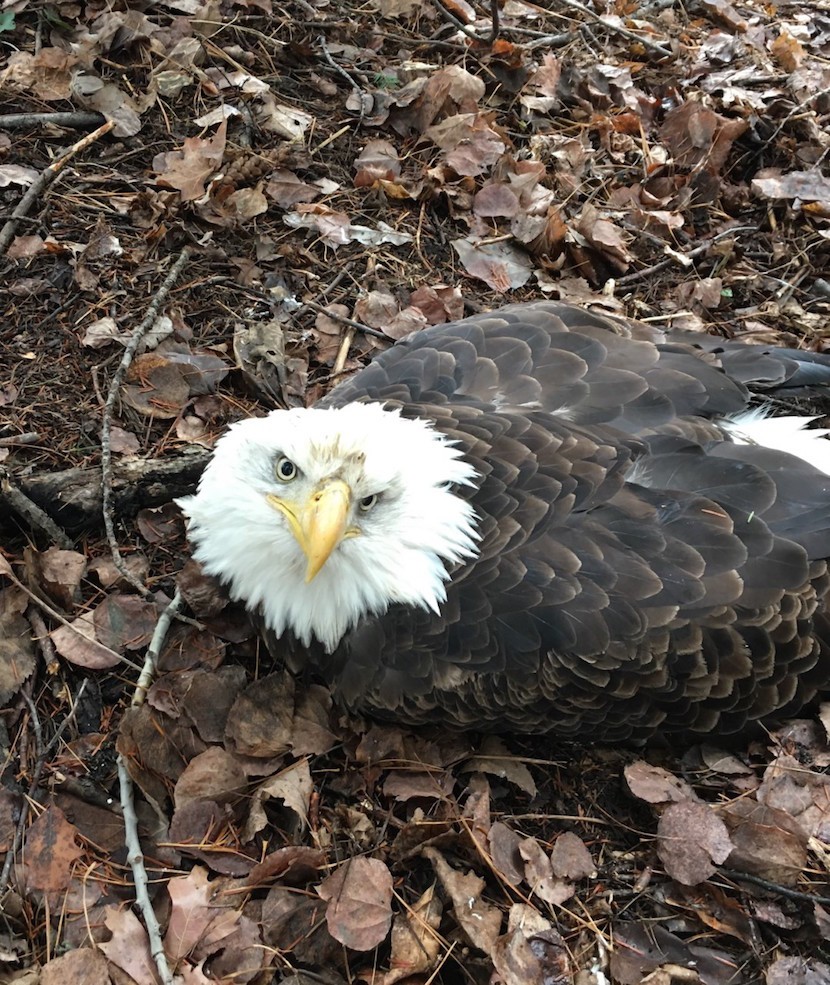
Taylor Hochstein DII Conservation Officer
On the morning of November 5, I received a phone call from concerned citizens near the Mille Lacs Band Cultural Immersion Grounds in Rutledge. They were concerned because there had been an adult eagle in their yard for the past 24 hours. The eagle was unable to maneuver or support its own weight. The homeowners told me that there were no apparent injuries but the eagle appeared to be ill and needed medical attention.
After receiving this information, I made a couple of phone calls and came up with a plan. I was able to coordinate with the fine folks at Wild and Free, a non-profit wildlife program involved in rescuing, rehabilitating, and releasing orphaned and/or injured wildlife back into the wild. They are located in Garrison. Although it was a Sunday (Wild and Free is closed on weekends), they were kind enough to come in and assess the eagle’s condition that day.
When I arrived at the homeowners’ residence, they directed me toward a balsam tree where the eagle was lying. With a pair of leather gloves and a blanket in hand, I approached the raptor. Using extreme caution, I tossed a blanket over the eagle and grabbed it, pinning its wings to its body. The eagle didn’t react very much, but it did let out an intimidating hissing noise. It also stuck its large talon out of the bottom of the blanket as if to remind me that it’s an apex predator (resides at the top of the avian food chain upon which no other creatures prey). I placed the eagle inside of a Rubbermaid container and put the container into the cage of my squad truck. With the heat on inside the truck, the eagle and I took a cruise to Garrison where I dropped it off at Wild and Free. When I dropped it off, it seemed to have perked up a bit, and I was hoping for the best.
I patiently waited for about a week before deciding to call Wild and Free to check up on the eagle. Wild and Free told me that after their assessment they had determined the eagle likely had lead poisoning. They said that they had sent it down to the Raptor Center at the University of Minnesota for further care and that I should call them to find out the status of the bird. I called the Raptor Center, and they regretfully told me that they had to euthanize the eagle due to severe lead poisoning. I was disappointed to say the least; anytime I pick up a wounded or orphaned animal I hope
for a success story. I asked the employees at both Wild and Free and the Raptor Center if they see a lot of eagles with lead poisoning. They told me they indeed do see a lot of it and the number of lead poisoned eagles increases during the fall hunting months.
Though disappointed by the outcome, I wanted to use this situation as a learning opportunity. I wanted to know what might have caused the lead poisoning and if it could have been avoid- ed. I found a lot of great articles and studies about eagle lead poisoning and ammunition projectile fragmentation (scattering of bullet lead in a hunted deer’s meat) online. I encourage anybody who hunts with lead bullets or shot to visit raptor.umn.edu to learn about the statistics and effects of lead poisoning in eagles and dnr.state.mn.us/hunting/ammo/lead.html to learn about projectile fragmentation and lead particles in harvested meat.
Even though a 1986 federal law banned the use of lead shot for waterfowl hunting, lead poisoning in the food chain still persists. A Minnesota Department of Natural Resources study shows that projectile fragmentation from commonly used lead bullets used in big game hunting left 141 lead fragments in a carcass with an average maximum distance of 11 inches from the wound channel and in one carcass a fragment was found up to 14 inches away from the exit wound. Studies show a spike in lead poisoned eagles beginning in mid-November continuing though winter. A connection can be made between the poisoned eagles and their food source — carcasses from deer that had either been shot and lost or injured and died later. Deer entrails (gut piles) left in the woods often contain lead fragments as well. When birds and other animals eat these remains, they are at risk of lead poisoning.
We have laws and regulations in place for waterfowl hunting mandating that a non-toxic steel shot must be used instead of lead. However, it is not illegal to use lead shot for small game in most circumstances. Lead bullets for big game hunting are very common and have become the standard.
After researching effects of lead poisoning on not only eagles but all animals within the food chain, I personally will be rethinking my ammunition choices. I will be switching to steel shot for all waterfowl/small game and a non-toxic copper bullet for big game.
Looking at the broader picture, I will also be eliminating the lead sinkers in my tackle box and be switching to a steel or tungsten alternative.
Whether it’s our family, friends or ourselves consuming the fish and game we harvest, I believe we should contemplate our own actions and how they may be helping or harming the food chain and the environment around us.